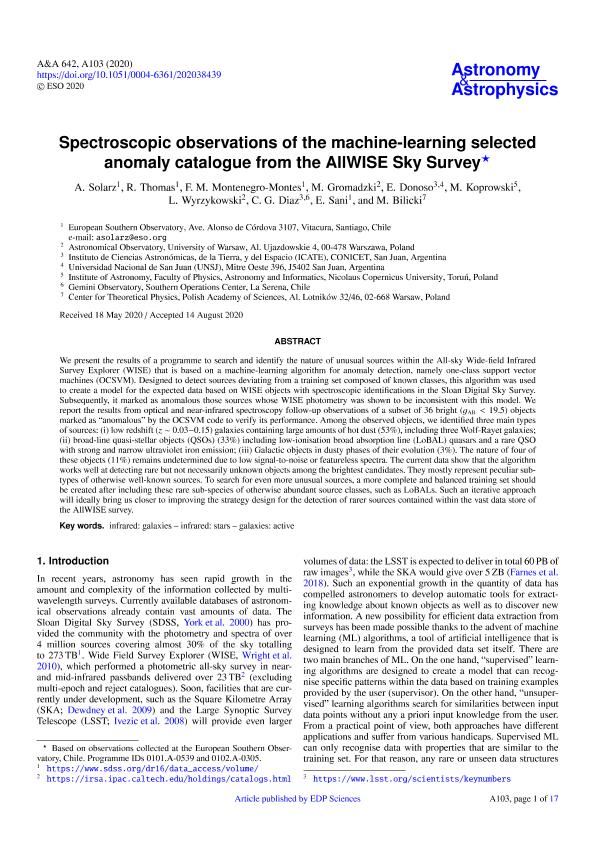Mostrar el registro sencillo del ítem
dc.contributor.author
Solarz, Aleksandra
dc.contributor.author
Thomas, Romain
dc.contributor.author
Montenegro Montes, Francisco
dc.contributor.author
Gromadzki, Mariusz
dc.contributor.author
Donoso, Emilio

dc.contributor.author
Koprowski, Maciej
dc.contributor.author
Wyrzykowski, Lukasz
dc.contributor.author
Diaz, Carlos Gonzalo

dc.contributor.author
Sani, Eleonora
dc.contributor.author
Bilicki, Maciej Andrzej
dc.date.available
2021-09-20T17:18:41Z
dc.date.issued
2020-10-12
dc.identifier.citation
Solarz, Aleksandra; Thomas, Romain; Montenegro Montes, Francisco; Gromadzki, Mariusz; Donoso, Emilio; et al.; Spectroscopic observations of the machine-learning selected anomaly catalogue from the AllWISE Sky Survey; EDP Sciences; Astronomy and Astrophysics; 642; A103; 12-10-2020; 1-17
dc.identifier.issn
0004-6361
dc.identifier.uri
http://hdl.handle.net/11336/140895
dc.description.abstract
We present the results of a programme to search and identify the nature of unusual sources within the All-sky Wide-field Infrared Survey Explorer (WISE) that is based on a machine-learning algorithm for anomaly detection, namely one-class support vector machines (OCSVM). Designed to detect sources deviating from a training set composed of known classes, this algorithm was used to create a model for the expected data based on WISE objects with spectroscopic identifications in the Sloan Digital Sky Survey. Subsequently, it marked as anomalous those sources whose WISE photometry was shown to be inconsistent with this model. We report the results from optical and near-infrared spectroscopy follow-up observations of a subset of 36 bright (gAB < 19.5) objects marked as "anomalous"by the OCSVM code to verify its performance. Among the observed objects, we identified three main types of sources: (i) low redshift (z ∼ 0.03 - 0.15) galaxies containing large amounts of hot dust (53%), including three Wolf-Rayet galaxies; (ii) broad-line quasi-stellar objects (QSOs) (33%) including low-ionisation broad absorption line (LoBAL) quasars and a rare QSO with strong and narrow ultraviolet iron emission; (iii) Galactic objects in dusty phases of their evolution (3%). The nature of four of these objects (11%) remains undetermined due to low signal-to-noise or featureless spectra. The current data show that the algorithm works well at detecting rare but not necessarily unknown objects among the brightest candidates. They mostly represent peculiar sub-types of otherwise well-known sources. To search for even more unusual sources, a more complete and balanced training set should be created after including these rare sub-species of otherwise abundant source classes, such as LoBALs. Such an iterative approach will ideally bring us closer to improving the strategy design for the detection of rarer sources contained within the vast data store of the AllWISE survey.
dc.format
application/pdf
dc.language.iso
eng
dc.publisher
EDP Sciences

dc.rights
info:eu-repo/semantics/openAccess
dc.rights.uri
https://creativecommons.org/licenses/by-nc-sa/2.5/ar/
dc.subject
GALAXIES: ACTIVE
dc.subject
INFRARED: GALAXIES
dc.subject
INFRARED: STARS
dc.subject.classification
Astronomía

dc.subject.classification
Ciencias Físicas

dc.subject.classification
CIENCIAS NATURALES Y EXACTAS

dc.title
Spectroscopic observations of the machine-learning selected anomaly catalogue from the AllWISE Sky Survey
dc.type
info:eu-repo/semantics/article
dc.type
info:ar-repo/semantics/artículo
dc.type
info:eu-repo/semantics/publishedVersion
dc.date.updated
2021-08-19T20:31:27Z
dc.journal.volume
642
dc.journal.number
A103
dc.journal.pagination
1-17
dc.journal.pais
Francia

dc.journal.ciudad
París
dc.description.fil
Fil: Solarz, Aleksandra. European Southern Observatory; Chile
dc.description.fil
Fil: Thomas, Romain. European Southern Observatory; Chile
dc.description.fil
Fil: Montenegro Montes, Francisco. European Southern Observatory; Chile
dc.description.fil
Fil: Gromadzki, Mariusz. University of Warsaw. Astronomical Observatory; Polonia
dc.description.fil
Fil: Donoso, Emilio. Consejo Nacional de Investigaciones Científicas y Técnicas. Centro Científico Tecnológico Conicet - San Juan. Instituto de Ciencias Astronómicas, de la Tierra y del Espacio. Universidad Nacional de San Juan. Instituto de Ciencias Astronómicas, de la Tierra y del Espacio; Argentina
dc.description.fil
Fil: Koprowski, Maciej. Nicolaus Copernicus. Faculty of Physics, Astronomy and Informatics. Institute of Astronomy; Polonia
dc.description.fil
Fil: Wyrzykowski, Lukasz. University of Warsaw. Astronomical Observatory; Polonia
dc.description.fil
Fil: Diaz, Carlos Gonzalo. Gemini Observatory. Southern Operations Center; Chile. Consejo Nacional de Investigaciones Científicas y Técnicas. Centro Científico Tecnológico Conicet - San Juan. Instituto de Ciencias Astronómicas, de la Tierra y del Espacio. Universidad Nacional de San Juan. Instituto de Ciencias Astronómicas, de la Tierra y del Espacio; Argentina
dc.description.fil
Fil: Sani, Eleonora. European Southern Observatory ; Chile
dc.description.fil
Fil: Bilicki, Maciej Andrzej. Polish Academy of Sciences; Argentina
dc.journal.title
Astronomy and Astrophysics

dc.relation.alternativeid
info:eu-repo/semantics/altIdentifier/doi/http://dx.doi.org/10.1051/0004-6361/202038439
dc.relation.alternativeid
info:eu-repo/semantics/altIdentifier/url/https://www.aanda.org/articles/aa/full_html/2020/10/aa38439-20/aa38439-20.html
Archivos asociados
